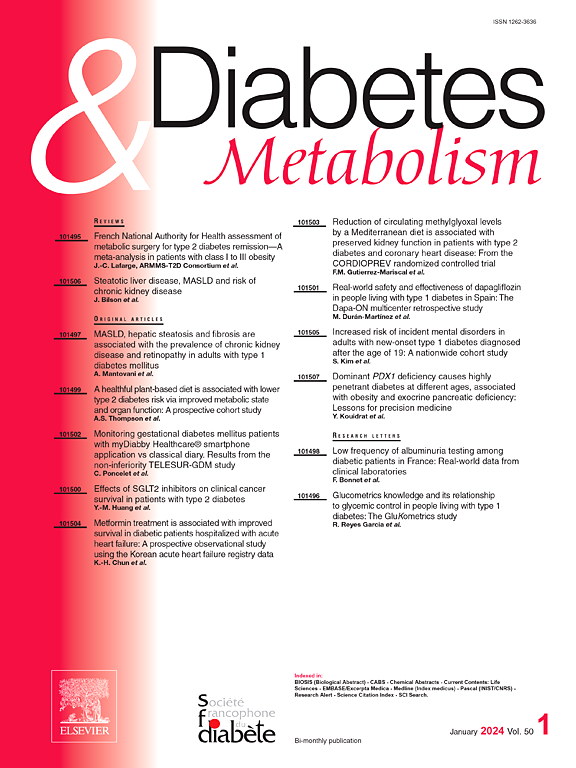模拟用乳制品代替肉类和20年2型糖尿病的累积发病率:来自ATTICA队列研究的见解(2002-2022)。
IF 4.7
2区 医学
Q1 ENDOCRINOLOGY & METABOLISM
引用次数: 0
摘要
目的:评估在表面健康的成年人中,用乳制品亚型(低脂、全脂和发酵)替代全肉、红肉和白肉与20年2型糖尿病(T2D)累积发病率之间的关系。方法:本分析包括参加ATTICA队列研究(2002-2022)的2000名基线时无动脉粥样硬化性心血管疾病和T2D的个体(年龄43±13岁;51%为女性)的数据。采用有效的半定量食物频率问卷评估食物摄入量。结果:20年T2D累计发病率为26.3% (95%CI[24.4, 28.3%])。在随访期间发生T2D的参与者报告的红肉摄入量明显高于未发生T2D的参与者(5.0次/周vs 4.5次/周;P = 0.016)。在完全调整的模型中,用全脂乳制品代替每1000千卡每天食用一份肉类的模型显示,20年T2D风险降低的趋势(P < 0.10) (OR 0.38, 95%CI [0.14, 1.05]);同样,用发酵乳制品代替每日一份/1000千卡的总肉类也有降低T2D风险的趋势(OR 0.39, 95%CI[0.15, 1.07])。用全脂乳制品代替红肉与T2D风险无关(OR每一天食用/1000千卡 = 0.37,95%CI [0.11, 1.19]);同样,低脂、发酵乳制品或白肉的替代品与糖尿病风险没有显著关联。结论:在模拟分析中,用全脂或发酵乳制品代替全肉和红肉/加工肉与T2D的长期风险存在潜在的有利关系,尽管在很大程度上不显著。本文章由计算机程序翻译,如有差异,请以英文原文为准。
Modelled substitution of meat with dairy products and the 20-year cumulative incidence of type 2 diabetes: Insights from the ATTICA cohort study (2002–2022)
Aim
To evaluate the association between modelled substitution of total, red, and white meat with dairy subtypes (low-fat, full-fat, and fermented) and the 20-year cumulative incidence of type 2 diabetes (T2D), among apparently healthy adults.
Methods
The present analysis included data from 2000 individuals free of atherosclerotic cardiovascular disease and T2D at baseline (age 43 ± 13 years; 51% women), participating in the ATTICA cohort study (2002–2022). Food intake was assessed using a validated semi-quantitative food-frequency questionnaire.
Results
The 20-year cumulative incidence of T2D was 26.3% (95%CI [24.4, 28.3%]). Participants who developed T2D during follow-up reported significantly higher red meat consumption compared to those who did not (5.0 vs. 4.5 times/week; P = 0.016). Modelled substitution of one daily serving of total meat per 1000 kcal with full-fat dairy, in fully adjusted models, suggested a trend (at P < 0.10) of lowering 20-year T2D risk (OR 0.38, 95%CI [0.14, 1.05]); similarly, substitution of one daily serving/1000 kcal of total meat with fermented dairy showed a trend of lowering T2D risk (OR 0.39, 95%CI [0.15, 1.07]). Substituting red meat with full-fat dairy was not associated with T2D risk (OR per one daily serving/1000 kcal = 0.37, 95%CI [0.11, 1.19]); similarly, substitutions with low-fat, fermented dairy or white meat showed not significant associations with T2D risk.
Conclusion
Substituting total and red/processed meat with full-fat or fermented dairy products in modeled analyses indicated potentially favorable, though largely non-significant, associations with long-term risk of T2D.
求助全文
通过发布文献求助,成功后即可免费获取论文全文。
去求助
来源期刊

Diabetes & metabolism
医学-内分泌学与代谢
CiteScore
12.00
自引率
4.20%
发文量
86
审稿时长
13 days
期刊介绍:
A high quality scientific journal with an international readership
Official publication of the SFD, Diabetes & Metabolism, publishes high-quality papers by leading teams, forming a close link between hospital and research units. Diabetes & Metabolism is published in English language and is indexed in all major databases with its impact factor constantly progressing.
Diabetes & Metabolism contains original articles, short reports and comprehensive reviews.
 求助内容:
求助内容: 应助结果提醒方式:
应助结果提醒方式:


